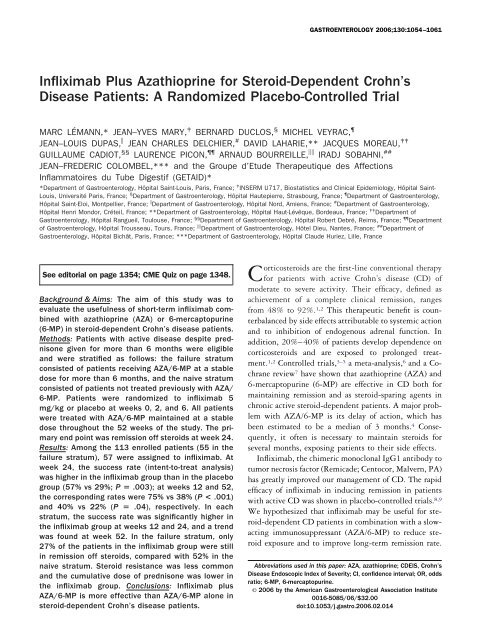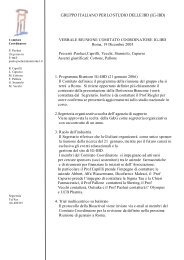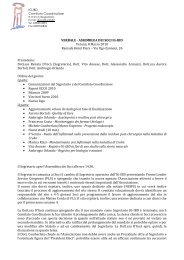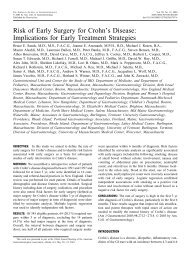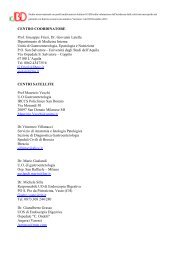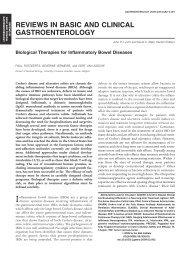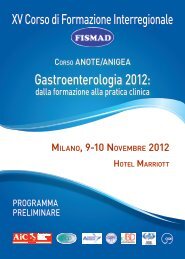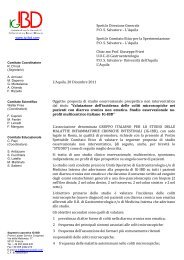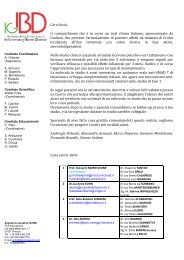marc lémann,* jean–yves mary,‡ bernard duclos,§ michel - IG-IBD
marc lémann,* jean–yves mary,‡ bernard duclos,§ michel - IG-IBD
marc lémann,* jean–yves mary,‡ bernard duclos,§ michel - IG-IBD
You also want an ePaper? Increase the reach of your titles
YUMPU automatically turns print PDFs into web optimized ePapers that Google loves.
Infliximab Plus Azathioprine for Steroid-Dependent Crohn’s<br />
Disease Patients: A Randomized Placebo-Controlled Trial<br />
MARC LÉMANN,* JEAN–YVES MARY, <strong>‡</strong> BERNARD DUCLOS, <strong>§</strong> MICHEL VEYRAC, <br />
JEAN–LOUIS DUPAS, JEAN CHARLES DELCHIER, # DAVID LAHARIE,** JACQUES MOREAU, <strong>‡</strong><strong>‡</strong><br />
GUILLAUME CADIOT, <strong>§</strong><strong>§</strong> LAURENCE PICON, ARNAUD BOURREILLE, IRADJ SOBAHNI, ##<br />
JEAN–FREDERIC COLOMBEL,*** and the Groupe d’Etude Therapeutique des Affections<br />
Inflammatoires du Tube Digestif (GETAID)*<br />
*Department of Gastroenterology, Hôpital Saint-Louis, Paris, France; <strong>‡</strong> INSERM U717, Biostatistics and Clinical Epidemiology, Hôpital Saint-<br />
Louis, Université Paris, France; <strong>§</strong> Department of Gastroenterology, Hôpital Hautepierre, Strasbourg, France; Department of Gastroenterology,<br />
Hôpital Saint-Eloi, Montpellier, France; Department of Gastroenterology, Hôpital Nord, Amiens, France; # Department of Gastroenterology,<br />
Hôpital Henri Mondor, Créteil, France; **Department of Gastroenterology, Hôpital Haut-Lévêque, Bordeaux, France; <strong>‡</strong><strong>‡</strong> Department of<br />
Gastroenterology, Hôpital Rangueil, Toulouse, France; <strong>§</strong><strong>§</strong> Department of Gastroenterology, Hôpital Robert Debré, Reims, France; Department<br />
of Gastroenterology, Hôpital Trousseau, Tours, France; Department of Gastroenterology, Hôtel Dieu, Nantes, France; ## Department of<br />
Gastroenterology, Hôpital Bichât, Paris, France; ***Department of Gastroenterology, Hôpital Claude Huriez, Lille, France<br />
See editorial on page 1354; CME Quiz on page 1348.<br />
Background & Aims: The aim of this study was to<br />
evaluate the usefulness of short-term infliximab combined<br />
with azathioprine (AZA) or 6-mercaptopurine<br />
(6-MP) in steroid-dependent Crohn’s disease patients.<br />
Methods: Patients with active disease despite prednisone<br />
given for more than 6 months were eligible<br />
and were stratified as follows: the failure stratum<br />
consisted of patients receiving AZA/6-MP at a stable<br />
dose for more than 6 months, and the naive stratum<br />
consisted of patients not treated previously with AZA/<br />
6-MP. Patients were randomized to infliximab 5<br />
mg/kg or placebo at weeks 0, 2, and 6. All patients<br />
were treated with AZA/6-MP maintained at a stable<br />
dose throughout the 52 weeks of the study. The pri<strong>mary</strong><br />
end point was remission off steroids at week 24.<br />
Results: Among the 113 enrolled patients (55 in the<br />
failure stratum), 57 were assigned to infliximab. At<br />
week 24, the success rate (intent-to-treat analysis)<br />
was higher in the infliximab group than in the placebo<br />
group (57% vs 29%; P .003); at weeks 12 and 52,<br />
the corresponding rates were 75% vs 38% (P < .001)<br />
and 40% vs 22% (P .04), respectively. In each<br />
stratum, the success rate was significantly higher in<br />
the infliximab group at weeks 12 and 24, and a trend<br />
was found at week 52. In the failure stratum, only<br />
27% of the patients in the infliximab group were still<br />
in remission off steroids, compared with 52% in the<br />
naive stratum. Steroid resistance was less common<br />
and the cumulative dose of prednisone was lower in<br />
the infliximab group. Conclusions: Infliximab plus<br />
AZA/6-MP is more effective than AZA/6-MP alone in<br />
steroid-dependent Crohn’s disease patients.<br />
GASTROENTEROLOGY 2006;130:1054–1061<br />
Corticosteroids are the first-line conventional therapy<br />
for patients with active Crohn’s disease (CD) of<br />
moderate to severe activity. Their efficacy, defined as<br />
achievement of a complete clinical remission, ranges<br />
from 48% to 92%. 1,2 This therapeutic benefit is counterbalanced<br />
by side effects attributable to systemic action<br />
and to inhibition of endogenous adrenal function. In<br />
addition, 20%–40% of patients develop dependence on<br />
corticosteroids and are exposed to prolonged treatment.<br />
1,2 Controlled trials, 3–5 a meta-analysis, 6 and a Cochrane<br />
review7 have shown that azathioprine (AZA) and<br />
6-mercaptopurine (6-MP) are effective in CD both for<br />
maintaining remission and as steroid-sparing agents in<br />
chronic active steroid-dependent patients. A major problem<br />
with AZA/6-MP is its delay of action, which has<br />
been estimated to be a median of 3 months. 4 Consequently,<br />
it often is necessary to maintain steroids for<br />
several months, exposing patients to their side effects.<br />
Infliximab, the chimeric monoclonal IgG1 antibody to<br />
tumor necrosis factor (Remicade; Centocor, Malvern, PA)<br />
has greatly improved our management of CD. The rapid<br />
efficacy of infliximab in inducing remission in patients<br />
with active CD was shown in placebo-controlled trials. 8,9<br />
We hypothesized that infliximab may be useful for steroid-dependent<br />
CD patients in combination with a slowacting<br />
immunosuppressant (AZA/6-MP) to reduce steroid<br />
exposure and to improve long-term remission rate.<br />
Abbreviations used in this paper: AZA, azathioprine; CDEIS, Crohn’s<br />
Disease Endoscopic Index of Severity; CI, confidence interval; OR, odds<br />
ratio; 6-MP, 6-mercaptopurine.<br />
© 2006 by the American Gastroenterological Association Institute<br />
0016-5085/06/$32.00<br />
doi:10.1053/j.gastro.2006.02.014
April 2006 INFLIXIMAB AND AZATHIOPRINE 1055<br />
The aim of the present study thus was to evaluate the<br />
usefulness of infliximab (3 infusions) combined with<br />
AZA/6-MP compared with AZA/6-MP alone for achieving<br />
clinical remission off steroids in steroid-dependent<br />
CD patients.<br />
Materials and Methods<br />
Patients<br />
Eligible patients were at least 18 years old and had<br />
luminal steroid-dependent CD. The diagnosis of CD was based<br />
on established clinical, endoscopic, radiologic, and histologic<br />
criteria. Steroid dependency was defined as follows: (1) prednisone<br />
had to be given for at least 6 months at a dosage 10<br />
mg/day or more, with no interruption for more than 2 months<br />
within the past 6 months; (2) at least 2 clinical luminal<br />
relapses when tapering of steroids had been attempted, leading<br />
to an increase in the dose to more than 10 mg/day; and (3) the<br />
last attempt for steroid tapering had to be within the past 6<br />
months. At baseline, patients had to be treated with prednisone<br />
10 mg/day or more. Regarding AZA/6-MP status at<br />
baseline, 2 types of patients could be included: those in the<br />
naive stratum who did not receive AZA/6-MP in the past 2<br />
years, and those in the failure stratum who still had clinically<br />
active disease (Crohn’s Disease Activity Index [CDAI] 150)<br />
despite receiving AZA/6-MP for more than 6 months at a<br />
stable and appropriate dose (2–3 mg/kg/day for AZA and<br />
1–1.5 mg/kg/day for 6-MP). Men and women with reproductive<br />
potential were required to practice birth control throughout<br />
the study and for 6 months after the last infliximab<br />
infusion.<br />
The exclusion criteria were as follows: (1) contraindication<br />
to AZA/6-MP or to infliximab according to labeling recommendations;<br />
(2) treatment with an immunosuppressive drug<br />
other than AZA/6-MP in the past 6 months; (3) previous use<br />
of infliximab or other anti–tumor necrosis factor drugs including<br />
thalidomide; (4) concomitant treatment with aminosalicylates,<br />
budesonide, topical steroids, or artificial nutrition; or<br />
(5) presence of at least 1 of the following conditions: symptomatic<br />
stricture, intra-abdominal abscess or infection, severe<br />
sepsis within the past 3 months, tuberculosis (because the<br />
bacillus Calmette-Guérin vaccination still is recommended in<br />
France, patients with a tuberculin skin test 10 mm and a<br />
bacillus Calmette-Guérin vaccination performed 10 years<br />
before the tuberculin skin test were excluded), history of B or<br />
C hepatitis, human immunodeficiency virus infection, liver<br />
failure, pregnancy, breast-feeding, or participation in pharmaceutical<br />
research within the past 3 months.<br />
Study Design<br />
This randomized, multicenter, double-blind, placebocontrolled<br />
trial was performed at 22 sites in France; all physicians<br />
were members of the Groupe d’Etude Thérapeutique<br />
des Affections Inflammatoires du tube Digestif (GETAID).<br />
The recruitment of patients took place from June 2000 to May<br />
2002.<br />
When the study was designed, we hypothesized that results<br />
could be different depending on whether or not patients<br />
received AZA/6-MP at inclusion. Patients thus were randomized<br />
per stratum (AZA/6-MP failure or naive) and per center to<br />
receive either infliximab or placebo in a 1:1 ratio. The randomization<br />
was performed centrally, using permutation tables<br />
of size 2 or 4 according to the number of patients that we<br />
anticipated would be enrolled at each center per stratum.<br />
The protocol was approved by the ethical committee (Comité<br />
Consultatif de Protection des Personnes dans La Recherche<br />
Biomédicale Paris Saint-Louis) for each participating center.<br />
Written informed consent was obtained from all patients<br />
before enrollment into the study.<br />
Treatments<br />
Infliximab/placebo. According to the randomization,<br />
patients received at 0, 2, and 6 weeks either a 2-hour<br />
infusion of infliximab (Remicade) administered at a dose of 5<br />
mg/kg or an infusion of an identical placebo. Neither the<br />
patients nor the study investigators were aware of the treatment<br />
assigned.<br />
Azathioprine/6-MP. All patients were treated with<br />
AZA (2–3 mg/kg per day) or 6-MP (1–1.5 mg/kg per day).<br />
Patients previously treated with AZA or 6-MP (failure stratum)<br />
continued their treatment at the same dose; in the<br />
naive-stratum patients, AZA (2–2.5 mg/kg per day) was<br />
started 1 week after the first infliximab infusion (to differentiate<br />
side effects related to infliximab from those related to<br />
AZA). The AZA or 6-MP dose had to be maintained at a stable<br />
dose throughout the study, except for patients who experienced<br />
toxicity related to the drug. If leukopenia (1500<br />
neutrophils/mL) or mild transaminase increases occurred (2<br />
times the upper limit of normal value), the AZA/6-MP dose<br />
was decreased by 50%.<br />
Steroids. At baseline, all patients were treated with<br />
prednisone or prednisolone at a daily dose of 10 mg or more.<br />
In patients with active disease (CDAI, 150), the steroid daily<br />
dose was increased by 15 mg. After 2 weeks, in patients with<br />
a clinical remission (CDAI, 150), steroids were tapered<br />
according to a standardized scheme (10 mg/wk to a daily dose<br />
of 20 mg, and then 5 mg/wk). If the CDAI still was more than<br />
150 after 2 weeks, the prednisone daily dose could be increased<br />
to 40 mg/day or 1 mg/kg of body weight/day. Throughout the<br />
study, in patients who experienced a relapse, steroids were<br />
reintroduced or increased until a new remission was achieved,<br />
and then tapered according to the same scheme.<br />
Patients who did not reach a clinical remission after 2 weeks<br />
with 40 mg/day or more were considered to be steroid resistant<br />
and were classified as treatment failures; they were offered<br />
infliximab infusion in an open-label fashion.<br />
Other treatments. Concomitant treatment that has<br />
been shown to facilitate steroid withdrawal in steroid-dependent<br />
patients such as mesalamine, budesonide, artificial nutrition,<br />
or other immunosuppressive drugs were not allowed<br />
during the study.
1056 LEMANN ET AL GASTROENTEROLOGY Vol. 130, No. 4<br />
Data Collection<br />
A complete medical history and current medications<br />
were recorded at study inclusion. Physical examination and<br />
laboratory tests (C-reactive protein, erythrocyte sedimentation<br />
rate, blood counts, liver tests) were performed at screening and<br />
at each visit (weeks 0, 2, 6, 12, 24, and 52). The CDAI, 10 a<br />
steroid side-effect score, and the cumulative doses of steroids<br />
also were calculated at each visit. A chest radiograph and<br />
tuberculin test were performed at inclusion and at week 24. A<br />
colonoscopy was performed, if the patient agreed, at baseline<br />
and at week 24, and the Crohn’s Disease Endoscopic Index of<br />
Severity (CDEIS) was calculated. 11 Adverse events were recorded<br />
at each visit and were classified as mild, moderate, or<br />
severe; the relationship to study medications also was evaluated.<br />
The CDAI10 was calculated by using patient reports of<br />
symptoms on diary cards within the week preceding each visit.<br />
The CDEIS was assessed according to the presence and the<br />
extent of lesions and ulcerations (deep or superficial), and<br />
according to the presence of ulcerated and nonulcerated strictures<br />
on the 5 following segments: rectum, sigmoid and left<br />
colon, transverse colon, right colon, and ileum. 11 The steroid<br />
side-effects score was calculated as follows: 1 point was attributed<br />
for each minor to moderate side effect including acne,<br />
swelling of the face, buffalo hump, striae, moderate increase in<br />
abdominal fat, insomnia or minor psychic disturbances, and<br />
other minor side effects; and 2 points for each severe side effect<br />
including amyotrophy and/or muscular weakness, pronounced<br />
cushingoid obesity, severe acne, diabetes mellitus, cataract,<br />
symptomatic bone complications, severe psychic disturbances,<br />
high blood pressure, or other severe side effects; the score could<br />
vary from 0 to 16.<br />
End Points<br />
All pri<strong>mary</strong> and secondary end points were prespecified.<br />
The pri<strong>mary</strong> efficacy end point was the rate of success,<br />
defined as a clinical remission (CDAI 150) 12 off steroids at<br />
week 24. Secondary efficacy end points were as follows: (1)<br />
success rate at week 12, (2) rate of steroid resistance, (3)<br />
cumulative dose of prednisone at week 24, (4) steroids sideeffect<br />
score at weeks 6, 12, and 24, (5) endoscopic improvement<br />
between inclusion and week 24, and (6) adverse events.<br />
A follow-up evaluation also was planned at week 52, with<br />
assessment of the success rate. During the follow-up period<br />
(weeks 24–52), all treatments could be given as necessary;<br />
patients who had a relapse or received additional infusions of<br />
infliximab were classified as treatment failures.<br />
Statistical Analysis<br />
The sample size calculation was based on the assumption<br />
that infliximab would be better than placebo (1-sided<br />
basis). We estimated that 128 patients were needed to detect<br />
a crude difference of 20% for the pri<strong>mary</strong> end point between<br />
placebo and infliximab, assuming a remission rate of 60% with<br />
the placebo, with a power of 80%. The analysis of efficacy was<br />
performed according to the intent-to-treat principle. All pa-<br />
tients enrolled and not lost to follow-up evaluation were<br />
included in the efficacy analysis, except if the CDAI was<br />
missing. The analysis of safety was conducted including all<br />
patients who had received at least 1 infusion of study medication.<br />
Categoric variables were described using frequencies and<br />
percentages and their distributions were compared between<br />
treatment groups, globally, and per stratum by using the 2<br />
test or the Fisher exact test. Continuous variables were summarized<br />
using the frequency, median, and interquartile range<br />
and their distributions were compared between treatment<br />
groups using the Mann–Whitney test.<br />
Success rates (the pri<strong>mary</strong> end point) were compared using<br />
the 2 test (globally and per stratum); the multiple logistic<br />
regression method also was used to estimate the odds ratio<br />
(OR) of success with 95% confidence intervals (CIs) and to test<br />
if the efficacy of infliximab compared with placebo was different<br />
across strata (interaction between treatment and stratum).<br />
Success at 12 or 52 weeks and steroid resistance were analyzed<br />
similar to the pri<strong>mary</strong> end point. The cumulative dose of<br />
prednisone, steroid side-effect score, and decrease in the CDEIS<br />
were analyzed using the Mann–Whitney test.<br />
Multivariate logistic regression analysis, adjusted on treatment<br />
and stratum, with backward selection using the likelihood<br />
ratio test, was used to look for factors measured at<br />
baseline that were independently predictive of success at week<br />
24. Variables were proposed to this analysis if the P value was<br />
less than .30 in the univariate analysis. Continuous factors<br />
were categorized as follows: each variable first was divided into<br />
4 categories at approximately the 25th, 50th, and 75th percentiles.<br />
If the ORs of adjacent categories were not statistically<br />
different, these categories were grouped. If no clear pattern was<br />
observed, the median was taken as a cut-off point. Usual<br />
limits, such as 150 for the CDAI, also were tested. The<br />
treatment effect and treatment-strata interaction were tested<br />
after adjustment on independent prognostic factors. Results<br />
were expressed as ORs with 95% CIs.<br />
Results were considered significant when the P value was<br />
less than .05. Data were analyzed with SPSS Software for<br />
Windows, release 6.1 (SPSS Inc, Chicago, IL).<br />
Results<br />
Baseline Characteristics of Patients<br />
The trial profile is shown in Figure 1. A total of<br />
115 patients were randomized (56 in the failure stratum/59<br />
in the naive stratum); 57 patients (26 in the<br />
failure stratum) were assigned randomly to receive infliximab<br />
and 58 patients (30 in the failure stratum) to<br />
receive placebo. Two patients allocated to placebo treatment<br />
(1 in each stratum) were not enrolled and did not<br />
receive the first infusion, 1 patient because his CDAI was<br />
less than 150 at inclusion and the other patient because<br />
he withdrew his consent before the inclusion visit.
April 2006 INFLIXIMAB AND AZATHIOPRINE 1057<br />
Figure 1. Flow chart of patients<br />
randomized in the trial. The figures<br />
in parentheses correspond<br />
to the number of patients in the<br />
naive stratum and the failure<br />
stratum, respectively.<br />
Characteristics of the 113 enrolled patients are<br />
shown in Table 1. Comparability of the 2 treatment<br />
groups was verified for all clinical characteristics, except<br />
for the percentage of patients with active perianal<br />
lesions, the CDAI level in failure stratum, and the<br />
duration of steroid treatments in the naive stratum.<br />
Efficacy<br />
The numbers of patients available for efficacy<br />
evaluation at weeks 12, 24, and 52 are shown in Figure<br />
1. At week 24, the percentage of success (CDAI 150<br />
and off steroids) was significantly higher in the infliximab<br />
group than in the placebo group (57% vs 29%;<br />
OR, 3.3; 95% CI, 1.5–7.4; P .003); the corresponding<br />
rates were 75% vs 38% (OR, 4.9; 95% CI, 2.2–11.0; P<br />
.001) at week 12, and 40% vs 22% (OR, 2.4; 95% CI,<br />
1.0–5.7; P .04) at week 52 (Figure 2).<br />
There was no significant interaction between treatment<br />
and stratum (P .10; .32, and .82 at weeks 12,<br />
24, and 52, respectively). The comparison of infliximab<br />
and placebo in each stratum is indicated in Figure 3. In<br />
the naive stratum, at week 24, the percentage of success<br />
was significantly higher in the infliximab group than in<br />
the placebo group (63% vs 32%; OR, 3.7; 95% CI,<br />
1.1–11.3; P .02); the corresponding rates were 83% vs<br />
41% (OR, 7.1; 95% CI, 2.1–24.9; P .009) at week 12,<br />
and 52% vs 32%; (OR, 2.3; 95% CI, .7–6.9; P .14)<br />
at week 52. In the failure stratum, the success rate also<br />
was higher in the infliximab group than in the placebo<br />
group at week 24 (50% vs 26%; OR, 2.9; 95% CI,<br />
.9–9.3; P .08) and at week 12 (64% vs 34%; OR, 3.4;<br />
95% CI, 1.1–10.3; P .03); a trend was found at week<br />
52 (27% vs 12%; OR, 2.8; 95% CI, .6–12.4; P .16).<br />
These results must be considered cautiously because of<br />
the absence of demonstrable interaction.<br />
Steroid resistance was less common in the infliximab<br />
group than in the placebo group (5% vs 23%;<br />
OR, 5.1; 95% CI, 1.3–19.2; P .01). The median<br />
cumulative dose (interquartile range) of prednisone<br />
was lower in the infliximab group at 1110 mg/24 wk<br />
(630–1720 mg/24 wk) vs 1870 mg/24 wk (1110–<br />
2710 mg/24 wk) (P .002). The median (interquartile<br />
range) of the side-effect steroid score, however,
1058 LEMANN ET AL GASTROENTEROLOGY Vol. 130, No. 4<br />
Table 1. Baseline Characteristics of the Patients Enrolled in the Trial According to Study Treatment and Stratum<br />
was not different in the 2 treatment groups at 2.0 (.0–4.0)<br />
vs 2.0 (1.0–4.0) at week 6 (P .65), 2.0 (.0–3.0) vs 1.0<br />
(.0–3.0) at week 12 (P .91), and 1.0 (.0–2.0) vs .5<br />
(.0–1.8) at week 24 (P .42). There was no significant<br />
interaction between treatment and stratum.<br />
Factors associated with success at week 24 in the<br />
multivariate logistic regression analysis were a low CDAI<br />
at baseline (OR, 4.5; 95% CI, 1.5–13.7; P .005), a<br />
Failure stratum Naive stratum<br />
Placebo n 29 Infliximab n 26 P Placebo n 27 Infliximab n 31 P<br />
Sex (female) a 69 69 .95 43 39 .75<br />
Age, yb 29 (23–33) 26 (22–37) .52 26 (22–36) 27 (22–38) .79<br />
Disease duration, yb Disease location<br />
7 (3–11) 5 (4–10) .97 4 (1–8) 3 (1–6) .60<br />
a<br />
Small bowel 11 20 .37 15 35 .74<br />
Colon 50 32 26 13<br />
Both 39 48 59 52<br />
Active perianal diseasea 14 35 .07 7 32 .02<br />
CDAIb 181 (154–259) 240 (219–281) .02 112 (42–262) 146 (90–244) .48<br />
Duration of steroids, mob 16 (9–36) 25 (13–36) .20 15 (9–52) 9 (7–22) .03<br />
Steroid dose, mg/dayb 30 (20–40) 33 (20–46) .32 25 (20–40) 25 (20–40) .85<br />
Steroid dose, mg/kg/dayb .5 (.3–.7) .6 (.4–.8) .25 .4 (.3–.6) .4 (.3–.6) .77<br />
Duration of AZA/6-MP, mob 21 (10–44) 27 (10–33) .95 0 0 -<br />
Dosage of AZA, c mg/kg/dayb 2.4 (2.1–2.6) 2.3 (2.0–2.5) .27 2.2 (2.0–2.4) 2.2 (2.0–2.4) .94<br />
Dosage of AZA, c mg/dayb 150 (125–150) 125 (100–150) .39 125 (100–150) 150 (125–150) .20<br />
CDEISb (n 52) 9 (6–15) d 9 (4–14) e .63 6 (3–14) f 11 (5–16) g .50<br />
C-reactive protein, b mg/L 8 (4–35) 19 (4–47) h .63 17 (7–31) i 20 (10–30) .36<br />
a Percent of patients; 2 test.<br />
b Median (interquartile range); Mann–Whitney U test.<br />
c All patients were treated with AZA.<br />
d n 17.<br />
e n 9.<br />
f n 14.<br />
g n 12.<br />
h n 25.<br />
i n 26.<br />
young age (OR, 5.9; 95% CI, 1.8–19.6; P .002), the<br />
absence of small-bowel involvement (OR, 4.3; 95% CI,<br />
1.5–12.2; P .004), and a long duration of steroids<br />
before entry (OR, 5.5; 95% CI, 1.3–22.5; P .01).<br />
After adjusting for these factors, infliximab still was<br />
superior to placebo (OR, 5.7; 95% CI, 2.0–15.9; P<br />
.001) and no interaction between treatment and strata<br />
could be seen (P .63).<br />
Figure 2. Percent of patients in<br />
clinical remission and off steroids<br />
at weeks 12, 24 (pri<strong>mary</strong><br />
end point), and 52 (follow-up<br />
evaluation). The figures below<br />
the bars correspond to the number<br />
of patients analyzed at each<br />
date. □, AZA/6-MP placebo;<br />
, AZA/6-MP infliximab 5<br />
mg/kg.
April 2006 INFLIXIMAB AND AZATHIOPRINE 1059<br />
Figure 3. Percent of patients in<br />
clinical remission and off steroids<br />
in the 2 strata at weeks<br />
12, 24 (pri<strong>mary</strong> end point), and<br />
52 (follow-up evaluation). The<br />
figures below the bars correspond<br />
to the number of patients<br />
analyzed at each date. □, AZA/<br />
6-MP placebo; , AZA/6-MP<br />
infliximab 5 mg/kg.<br />
Endoscopy<br />
Colonoscopy was performed at baseline in 52<br />
patients (21 in the infliximab group and 31 in the<br />
placebo group); 20 of them had a second colonoscopy at<br />
week 24 (11 in the infliximab group and 9 in the placebo<br />
group). CDEIS decrease (median [interquartile range])<br />
from baseline to week 24 was 6.9 (4.1–9.5) in the<br />
infliximab group and 1.2 (1.5 to 4.4) in the placebo<br />
group (P .05). The number of patients with no ulceration<br />
at week 24 was 3 of 11 (27%) and 3 of 9 (33%) in<br />
the infliximab and placebo groups, respectively (P <br />
.77).<br />
Among the 16 patients in remission and off steroids at<br />
week 24 (9 in the infliximab group and 7 in the placebo<br />
group), the CDEIS decrease (median [interquartile<br />
range]) was higher in the infliximab group than in the<br />
placebo group, 6.9 (1.2–10.2) vs 1.2 (.0–4.0) (P .05);<br />
the CDEIS decrease was more than 5 in 6 of the 9<br />
patients in the infliximab group and in 0 of the 7<br />
patients in the placebo group (P .01). The number of<br />
patients with no ulceration at week 24 was 3 of 9 (33%)<br />
and 3 of 7 (43%) in the infliximab and placebo groups,<br />
respectively (P .70).<br />
Safety<br />
The frequency and severity of adverse events were<br />
not different between the 2 treatment groups (Table 2).<br />
The percent of patients who had at least 1 adverse event<br />
was 51% (29 of 57) in the infliximab group and 50% (28<br />
of 56) in the placebo group. The frequency of infection<br />
was similar in the 2 treatment groups. Of note, 5 serious<br />
adverse events were probably or possibly related to azathioprine<br />
(Table 2). One patient in the infliximab group<br />
had a severe reaction after the second and third infusions<br />
(2%). No malignancy and no deaths occurred among the<br />
study patients.<br />
Discussion<br />
Our study was designed to show the superiority of<br />
treatment with a combination of AZA/6-MP with infliximab<br />
(3 infusions at 0, 2, and 6 weeks), compared with<br />
AZA/6-MP alone, in patients with steroid-dependent<br />
CD. With the addition of infliximab to AZA/6-MP we<br />
showed the following: (1) the rate of success was nearly<br />
doubled, defined as complete clinical remission (CDAI,<br />
150) without steroids from 38% to 75% at week 12,<br />
from 29% to 57% at week 24, and from 22% to 40% at<br />
52 weeks; the corresponding odds of success were increased<br />
by a factor of about 5, 3.5, and 2.5; and (2) it<br />
reduces exposure to steroids. Although we found that<br />
infliximab was associated with lower steroid consumption,<br />
steroid side effects were not decreased significantly<br />
by infliximab.<br />
Infliximab thus could be used as a bridge, waiting for<br />
the delayed effect of AZA/6-MP. An important point to<br />
consider in clinical practice, however, is whether or not<br />
the bridge effect is holding with time. Two different<br />
situations could be seen here. In patients with previous<br />
failure to AZA/6-MP, a loss of efficacy was observed<br />
gradually, and at week 52 only 27% of the patients were<br />
still in remission off steroids in the infliximab group. In<br />
such patients, the bridge strategy thus is questionable.<br />
The majority of patients probably would benefit from<br />
optimization of AZA/6-MP treatment using higher doses<br />
adjusted to 6-thioguanine nucleotide levels (which was<br />
not made systematically in our study), or from the switch
1060 LEMANN ET AL GASTROENTEROLOGY Vol. 130, No. 4<br />
Table 2. Adverse Events Occurring During the Study Period:<br />
Day 0 to Week 24<br />
Number of events<br />
in the infliximab<br />
group<br />
Number of events<br />
in the placebo<br />
group<br />
Total 79 66<br />
Mild 39 27<br />
Moderate 36 30<br />
Severe 4 a 9 a<br />
Infections 18 16<br />
Upper respiratory tract 8 11 b<br />
Dental 2 1<br />
Otitis 0 1<br />
Cutaneous 3 1<br />
Herpes virus 2 0<br />
Urinary tract 1 1<br />
Intestinal 1 0<br />
Perianal abscess 0 1 c<br />
Pelvic abscess 1 d 0<br />
Arthralgia, myalgia 8 13 e<br />
Abdominal pain, diarrhea 9 5<br />
Nausea or vomiting 10 e 3<br />
Headache 6 4<br />
Cutaneous rash, pruritus 5 7 e<br />
Fatigue 5 2<br />
Reaction to infusion 2 f 0<br />
Fever 1 4<br />
Mild increase of<br />
transaminase levels<br />
1 0<br />
Pancreatitis 0 e 2 e<br />
Miscellaneous 14 10<br />
a Serious adverse event in 5 cases (infliximab, n 3; placebo, n 3).<br />
b One patient in the placebo group also had a severe pneumonitis<br />
caused by Legionella pneumophila during the follow-up period, and<br />
recovered with antibiotics.<br />
c Perianal abscess occurring at week 18; surgical treatment.<br />
d Pelvic abscess discovered at week 24; surgical treatment.<br />
e Five patients had adverse events possibly or probably related to<br />
azathioprine, 1 in the infliximab group (severe vomiting, week 6), and<br />
4 in the placebo group including 1 case of arthralgia, myalgia, cough,<br />
diarrhea, and fever (week 6), 1 case of arthralgia, fever, and cutaneous<br />
rash (week 6), and 2 cases of pancreatitis (weeks 4 and 5); all<br />
the patients stopped azathioprine and recovered. One additional case<br />
of pancreatitis occurred in the infliximab group at week 23 during the<br />
follow-up period, azathioprine was stopped but the cause remained<br />
unclear because biliary stones also were found.<br />
f Two severe reactions in the same patient, 1 after the second infliximab<br />
infusion and the other after the third infusion; the patient<br />
recovered with steroids and adrenalin.<br />
to another immunosuppressant such as methotrexate or<br />
to maintenance treatment with infliximab. In contrast,<br />
among patients naive for AZA/6-MP at inclusion, despite<br />
a similar loss of efficacy with time, more than 50%<br />
were always in remission and off steroids at 1 year. In<br />
such patients the strategy of using infliximab as a bridge<br />
between steroids and AZA/6-MP could be considered.<br />
Optimization of AZA/6-MP treatment also may have, in<br />
this setting, improved long-term results. By comparison,<br />
in the ACCENT 1 infliximab maintenance trial, responders<br />
to the initial infusion of infliximab (n 335)<br />
were randomized to infliximab (5 mg/kg) or placebo at<br />
weeks 2 and 6, and then to infusions of infliximab 5<br />
mg/kg, 10 mg/kg, or placebo every 8 weeks. At week 54,<br />
the rates of remission and off steroids were 24%, 32%,<br />
and 9%, respectively. 9 However, in this study only 29%<br />
of patients were treated with immunosuppressants at<br />
baseline.<br />
A potential drawback of the bridge strategy is that the<br />
interruption of infliximab after an induction scheme<br />
could facilitate the development of anti-infliximab antibody,<br />
and thus compromise a re-treatment with infliximab,<br />
if necessary. 13,14 Unfortunately, we were not able<br />
to assess the anti-infliximab antibody in our trial. The<br />
risk of immunization must be weighed against the potential<br />
for increased toxicity 15 and cost for patients receiving<br />
regular maintenance treatment. In the present<br />
study, the crude number and the rate of adverse events<br />
were not different in the 2 treatment groups. However,<br />
there is still some uncertainty regarding the long-term<br />
safety of maintenance infliximab including infections and<br />
the development of lymphoproliferative disorders. 16,17<br />
In our study, the rather low effectiveness of AZA/<br />
6-MP alone in the naive stratum for steroid-dependent<br />
patients (32% of success at 24 and 52 weeks) compared<br />
with previous studies 3,4,6 was probably the effect of the<br />
stringent criterion of success that was used (ie, remission<br />
off steroids). Moreover, all the patients included in our<br />
study were steroid-dependent, although this was not<br />
always the case in previous studies. On the other hand, a<br />
remarkably high success rate (83%) was observed in the<br />
infliximab group at week 12. This may be owing to<br />
concurrent AZA/6-MP therapy. Two retrospective and 4<br />
prospective studies that comprised a total of 738 patients<br />
with active CD reported a trend toward a higher response<br />
to infliximab in patients receiving concurrent immunosuppressants<br />
compared with those not receiving any immunosuppressants.<br />
18<br />
A subgroup of patients had a colonoscopic evaluation<br />
during our study. Despite the small number of patients,<br />
endoscopic improvement was more pronounced in the<br />
infliximab group than in the placebo group. When the<br />
comparison was restricted to patients in clinical remission<br />
and off steroids at week 24 (n 16), the superiority<br />
of infliximab was confirmed. Even if a selection bias<br />
cannot be ruled out, this result confirms a previous report<br />
of mucosal healing with infliximab. 14<br />
In conclusion, our study shows that the combination<br />
of infliximab with azathioprine is more effective than<br />
azathioprine alone in steroid-dependent patients to<br />
achieve remission without steroids, and to reduce exposure<br />
to steroids. In AZA/6-MP–naive patients, infliximab<br />
could be used as a bridge between steroids and
April 2006 INFLIXIMAB AND AZATHIOPRINE 1061<br />
azathioprine. If a relapse occurs, regular maintenance<br />
therapy with infliximab should be considered. One cannot<br />
exclude, however, that the continuation of regular<br />
infusions of infliximab combined with AZA/6-MP could<br />
have resulted in a better success rate in our specific study<br />
population. This point should be tested in future studies.<br />
In AZA/6-MP–treatment failure patients, a loss of effectiveness<br />
was observed gradually, and the bridge strategy<br />
cannot be recommended. Other options such as infliximab<br />
maintenance should be considered.<br />
References<br />
1. Modigliani R, Mary JY, Simon JF, Cortot A, Soulé JC, Gendre JP,<br />
Rene E. Clinical, biological, and endoscopic picture of attacks of<br />
Crohn’s disease. Evolution on prednisolone. Groupe d’Etude<br />
Therapeutique des Affections Inflammatoires Digestives. Gastroenterology<br />
1990;98:811–818.<br />
2. Munkholm P, Langholz E, Davidsen M, Binder V. Frequency of<br />
glucocorticoid resistance and dependency in Crohn’s disease.<br />
Gut 1994;35:360–362.<br />
3. Candy S, Wright J, Gerber M, Adams G, Gerig M, Goodman R. A<br />
controlled double blind study of azathioprine in the management<br />
of Crohn’s disease. Gut 1995;37:674–678.<br />
4. Present DH, Korelitz BI, Wisch N, Glass JL, Sachar DB, Pasternack<br />
BS. Treatment of Crohn’s disease with 6-mercaptopurine. A<br />
long-term, randomized, double-blind study. N Engl J Med 1980;<br />
302:981–987.<br />
5. O’Donoghue DP, Dawson AM, Powel-Tuck K, Bown RL. Doubleblind<br />
withdrawal of azathioprine as maintenance treatment for<br />
Crohn’s disease. Lancet 1978;2:944–946.<br />
6. Pearson DC, May GR, Fick GH, Sutherland LR. Azathioprine and<br />
6-mercaptopurine in Crohn’s disease. A meta-analysis. Ann Intern<br />
Med 1995;123:132–142.<br />
7. Pearson DC, May GR, Fick G, Sutherland LR. Azathioprine for<br />
maintaining remission of Crohn’s disease. Cochrane Database<br />
Syst Rev 2000;(2):CD000067.<br />
8. Targan SR, Hanauer SB, van Deventer SJ, Mayer L, Present DH,<br />
Braakman T, DeWoody KL, Schaible TF, Rutgeerts PJ. A shortterm<br />
study of chimeric monoclonal antibody cA2 to tumor necrosis<br />
factor alpha for Crohn’s disease. Crohn’s Disease cA2 Study<br />
Group. N Engl J Med 1997;337:1029–1035.<br />
9. Hanauer SB, Feagan BG, Lichtenstein GR, Mayer LF, Schreiber S,<br />
Colombel JF, Rachmilewitz D, Wolf DC, Olson A, Bao W, Rutgeerts<br />
P. Maintenance infliximab for Crohn’s disease: the ACCENT I<br />
randomised trial. Lancet 2002;359:1541–1549.<br />
10. Best WR, Becktel JM, Singleton JW, Kern F. Development of a<br />
Crohn’s disease activity index. National Cooperative Crohn’s Disease<br />
Study. Gastroenterology 1976;70:439–444.<br />
11. Mary JY, Modigliani R. Development and validation of an endoscopic<br />
index of the severity for Crohn’s disease: a prospective multicentre<br />
study. Groupes d’ Etudes Thérapeutiques des Affections Inflammatoires<br />
du Tube Digestif (GETAID). Gut 1989;30:983–989.<br />
12. Sandborn WJ, Feagan BG, Hanauer SB, Lochs H, Lofberg R,<br />
Modigliani R, Present DH, Rutgeerts P, Scholmerich J, Stange EF,<br />
Sutherland LR. A review of activity indices and efficacy endpoints<br />
for clinical trials of medical therapy in adults with Crohn’s disease.<br />
Gastroenterology 2002;122:512–530.<br />
13. Baert F, Noman M, Vermeire S, Van Assche G, D’Haens G,<br />
Carbonez A, Rutgeerts P. Influence of immunogenicity on the<br />
long-term efficacy of infliximab in Crohn’s disease. N Engl J Med<br />
2003;348:601–608.<br />
14. Rutgeerts P, Feagan BG, Lichtenstein GR, Mayer LF, Schreiber S,<br />
Colombel JF, Rachmilewitz D, Wolf DC, Olson A, Bao W, Hanauer<br />
SB. Comparison of scheduled and episodic treatment strategies<br />
of infliximab in Crohn’s disease. Gastroenterology 2004;126:<br />
402–413.<br />
15. Colombel JF, Loftus EV Jr, Tremaine WJ, Egan LJ, Harmsen WS,<br />
Schleck CD, Zinsmeister AR, Sandborn WJ. The safety profile<br />
of infliximab in patients with Crohn’s disease: the Mayo Clinic<br />
Experience in 500 patients. Gastroenterology 2004;126:19–<br />
31.<br />
16. Ljung T, Karlen P, Schmidt D, Hellstrom PM, Lapidus A, Janczewska<br />
I, Sjoqvist U, Lofberg R. Infliximab in inflammatory bowel<br />
disease: clinical outcome in a population based cohort from<br />
Stockholm County. Gut 2004;53:849–853.<br />
17. Wolfe F, Michaud K. Lymphoma in rheumatoid arthritis: the effect<br />
of methotrexate and anti-tumor necrosis factor therapy in 18,572<br />
patients. Arthritis Rheum 2004;50:1740–1751.<br />
18. Su C, Lichtenstein GR. Are there predictors of Remicade treatment<br />
success or failure? Adv Drug Deliv Rev 2005;57:237–245.<br />
Received March 21, 2005. Accepted December 28, 2005.<br />
Address requests for reprints to: Professor Marc Lémann, MD, PhD,<br />
Service de Gastroentérologie, 1 avenue Claude Vellefaux, 75010,<br />
Paris, France. e-mail: <strong>marc</strong>@lemann.com; fax: (33) 1-42-49-91-68.<br />
Presented in part at the Digestive Disease Week, Orlando, May<br />
17-22, 2003, and at the United European Gastroenterology Week<br />
(1-year follow-up), Madrid, November 1-5, 2003.<br />
Supported by Groupe d’Etude Thérapeutique des Affections Inflammatoires<br />
du tube Digestif (GETAID), and by grants from Schering Plough, France,<br />
with the specific help of Gérard Trape and Yves-Dominique Henry. Drugs were<br />
provided by Schering Plough, France. All data analysis and manuscript writing<br />
were performed independently by the GETAID, without the involvement of<br />
representatives of Schering Plough.<br />
In addition to the authors, the following French investigators participated in<br />
the study: Robert Modigliani, Hôpital Saint-Louis, Paris, France; Etienne-Henry<br />
Metman, Hôpital Trousseau Tours; Jean-Paul Galmiche, Hôtel Dieu, Nantes,<br />
France; Jean-Pierre Gendre, Hôpital Saint-Antoine, Paris, France; Marc-André<br />
Bigard, Hôpital Brabois, Nancy, France; Stanislas Chaussade and Vered Abitbol,<br />
Hôpital Cochin, Paris, France; Jean-Charles Grimaud, Hôpital Nord, Marseille,<br />
France; Gilles Bommelaer, Hotel Dieu, Clermont-Ferrand, France; Jean-<br />
Claude Soulé, Hôpital Bichât, Paris, France; Bruno Bonaz, Hôpital Nord,<br />
Grenoble, France; Louis Descos and Bernard Flourié, Hôpital Lyon-Sud, Lyon,<br />
France; Eric Lerebours, Hôpital Charles Nicolle, Rouen, France; Benoit Coffin,<br />
Hôpital Louis Mourier, Colombes, France.<br />
The authors acknowledge Patricia Détré, Study Coordinator, for her<br />
technical help.


